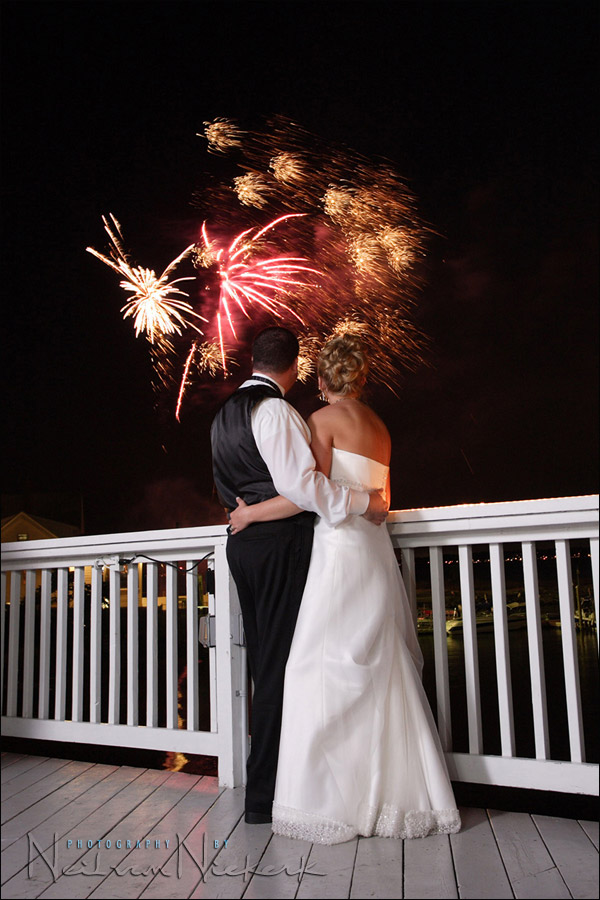
Photographing fireworks, using flash
Generally, you wouldn’t use flash to photography fireworks. But when you have someone in the foreground, then it becomes useful to have your subject lit up with flash, to balance them with the background (the fireworks display.)
Photographing people with fireworks in the background, is just an application of the technique known as dragging the shutter. I had the couple in an area where there wasn’t much ambient light, so that I could light them mostly with flash. The strobe was a Quantum T2 with an umbrella, used in manual.
My flash exposure was determined in that I wanted the couple correctly exposed .. but my actual settings were dictated by my choices made in how I wanted the fireworks to register.
For my fireworks exposure, which is considered the same as ambient light,
I had to juggle the three controls again: shutter speed / aperture / ISO.
That particular photograph was 1 sec @ f6.7 @ 400 ISO
You don’t necessarily want a high ISO setting, since you do want your shutter speed to be slow. Slow enough to record the fireworks as streaks of light. There is a lot of leeway here, and a quick check of your camera’s preview will tell you whether you need to adjust your settings. Therefore your is range should be 100 to 400 ISO. Then your shutter speed is in the region of 1 second or slower. In other words, you need a tripod.
Recording multiple bursts of fireworks by blanking out the frame with a black card is a great idea. This photograph was a single exposure though. By checking my camera to see how other firework bursts recorded, I found that f6.7 @ 400 ISO @ 1 sec gave me enough firework trails and the fireworks itself weren’t over-exposed in the shot.
So using f6.7 @ 400 ISO, I set my Quantum T2 to an appropriate power level, to give me that exposure. (Manual flash in this instance, since my subject was in a specific position in relation to my strobe.)
An exposure of f4.5 @ 200 ISO @ 2 seconds, would’ve given me exactly the same exposure, but the firework trails would’ve been longer. There is a lot of leeway here, and you shouldn’t be bound by specific settings. But my suggestion would be to start at 1 second (or slower) and 400 or 20O ISO, then then chimp to taste.
Note that rear-curtain sync would not have had any effect here, since the couple was static in the frame.
Related articles
- More articles on using off-camera flash
Soy una fotografa en sus comienzos y mi ingles es muy básico. Te pido porfavor que traduzcan tu página pues parece ser muy interesante
muchas gracias
Deminge Andrea
Fotografiando a gente con los fuegos artificiales en el fondo, es apenas un uso de la técnica conocida como fricción del obturador.
Tenía los pares en un área donde no había mucha luz ambiente, de modo que pudiera encenderlos sobre todo con el flash. El estroboscópico era un T2 de Quantum con un paraguas. Mi exposición de destello fue determinada en que quise los pares expuestos correctamente. pero mis ajustes reales fueron dictados por mis decisiones tomadas en cómo quisiera que los fuegos artificiales se colocaran. Para mi exposición de los fuegos artificiales, tuve que hacer juegos malabares los tres controles otra vez: velocidad de obturador/abertura/ISO. Esa fotografía particular era 1 ISO f6.7 @ 400 del sec @ Usted no quiere necesariamente una alta ISO, porque usted quisiera que su velocidad de obturador fuera lenta.
Retárdese bastante para registrar los fuegos artificiales como rayas de la luz. Hay mucha deriva aquí, y el chimping le dirá si usted necesita ajustar sus ajustes. Por lo tanto su es la gama debe ser ISO 100 a 400. Entonces su velocidad de obturador debe ser 1 segundo o más lento. Es decir usted necesita un trípode. La registración de explosiones múltiples de fuegos artificiales escondiendo hacia fuera el marco con una tarjeta negra es una gran idea. Esta fotografía era una sola exposición sin embargo.
Chimping el otro fuego artificial estalla, encontré que f6.7 @ 1 sec de la ISO 400 @ me dio bastantes rastros del fuego artificial y los fuegos artificiales sí mismo no over-exposed en el tiro. Tan usando f6.7 @ 400 ISO, fijé mi T2 de Quantum a un nivel de energía apropiado, para darme esa exposición. (Flash manual en este caso, puesto que mi tema estaba en una posición específica en lo referente a mi estroboscópico.) ISO f4.5 @ 200 @ 2 segundos. me habría dado exactamente la misma exposición, pero los rastros del fuego artificial habrían sido más largos.
Hay mucha deriva aquí, y usted no debe ser limitado por los ajustes específicos. Pero mi sugerencia sería comenzar en 1 segundo (o más lento) y 400 o 20O ISO, entonces entonces chimpancé a probar. la sinc. de la Posterior-cortina no habría tenido ninguÌn efecto aquí, puesto que el par era estático en el marco.
awesome craftsmanship